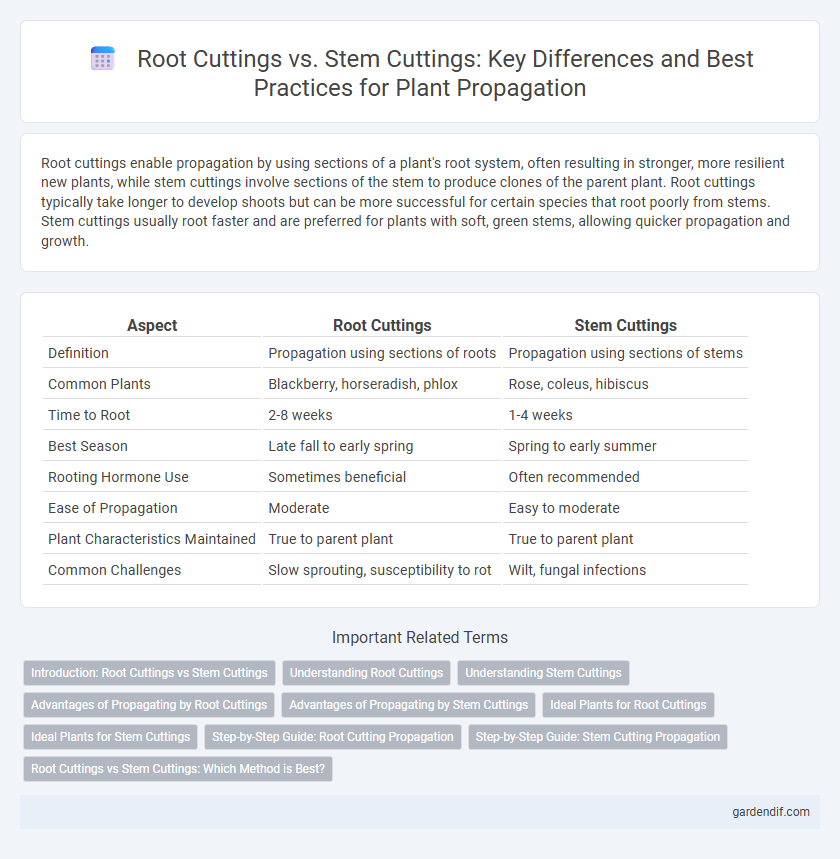
Root Cuttings vs Stem Cuttings Illustration
Root cuttings enable propagation by using sections of a plant's root system, often resulting in stronger, more resilient new plants, while stem cuttings involve sections of the stem to produce clones of the parent plant. Root cuttings typically take longer to develop shoots but can be more successful for certain species that root poorly from stems. Stem cuttings usually root faster and are preferred for plants with soft, green stems, allowing quicker propagation and growth.
Table of Comparison
| Aspect | Root Cuttings | Stem Cuttings |
|---|---|---|
| Definition | Propagation using sections of roots | Propagation using sections of stems |
| Common Plants | Blackberry, horseradish, phlox | Rose, coleus, hibiscus |
| Time to Root | 2-8 weeks | 1-4 weeks |
| Best Season | Late fall to early spring | Spring to early summer |
| Rooting Hormone Use | Sometimes beneficial | Often recommended |
| Ease of Propagation | Moderate | Easy to moderate |
| Plant Characteristics Maintained | True to parent plant | True to parent plant |
| Common Challenges | Slow sprouting, susceptibility to rot | Wilt, fungal infections |
Introduction: Root Cuttings vs Stem Cuttings
Root cuttings and stem cuttings are two common propagation methods used for multiplying plants efficiently. Root cuttings involve using sections of roots to generate new plants, especially effective for herbaceous perennials and woody plants. Stem cuttings utilize portions of stems, often preferred for shrubs and houseplants, allowing for faster rooting and growth under suitable conditions.
Understanding Root Cuttings
Root cuttings involve propagating plants by using sections of the root, allowing new shoots to develop from dormant buds. This method is particularly effective for plants with vigorous root systems, such as horseradish, raspberries, and some perennials. Root cuttings typically produce stronger, hardier plants compared to stem cuttings, as they establish roots before shoots emerge.
Understanding Stem Cuttings
Stem cuttings involve taking a portion of a plant's stem to propagate new growth, capitalizing on the stem's ability to develop roots and shoots. This method is effective for many woody and herbaceous plants because stems contain nodes rich in meristematic tissue, enabling rapid root formation. Proper selection of healthy, disease-free stem sections with multiple nodes increases the success rate of propagation and ensures vigorous plant development.
Advantages of Propagating by Root Cuttings
Propagating plants through root cuttings offers several advantages, including the ability to produce genetically identical, robust plants with well-established root systems that ensure faster acclimatization and growth. Root cuttings often result in higher success rates compared to stem cuttings, especially for species with difficult-to-root stems. This method also reduces the risk of disease transmission and stress, promoting healthier propagation and long-term plant vitality.
Advantages of Propagating by Stem Cuttings
Propagating by stem cuttings offers rapid root development and higher success rates compared to root cuttings, especially in plants with flexible stems like coleus and geranium. Stem cuttings enable the production of genetically identical clones, ensuring the preservation of desirable traits and uniform growth. This method requires less time and resources, facilitating efficient propagation in horticultural and commercial settings.
Ideal Plants for Root Cuttings
Ideal plants for root cuttings include hardy perennials such as hostas, blackberries, and raspberry bushes, which regenerate effectively from root fragments. Root cuttings excel with plants exhibiting vigorous root systems, like horseradish and poplar trees, enabling faster propagation and resilience against diseases. This method suits species with strong underground structures, ensuring higher success rates compared to stem cuttings for certain shrubs and herbaceous plants.
Ideal Plants for Stem Cuttings
Ideal plants for stem cuttings include soft-stemmed species such as Coleus, Geranium, and Fuchsia, which readily root from healthy stem segments. Woody plants like willow, hydrangea, and hibiscus also respond well to stem cuttings, especially when taken during active growth. Selecting vigorous, disease-free stems enhances rooting success and accelerates propagation in these species.
Step-by-Step Guide: Root Cutting Propagation
Root cutting propagation begins by selecting healthy roots from a mature plant, ensuring they are at least 3 to 6 inches long and about 1/4 to 1/2 inch in diameter. After carefully digging up the root sections, cut them at a slight angle, removing any damaged parts and treating the cut ends with rooting hormone to enhance growth potential. Plant the prepared root cuttings horizontally in a well-draining potting mix, keep the medium consistently moist, and maintain a warm environment of 65-75degF to encourage new shoots and roots development within 3 to 6 weeks.
Step-by-Step Guide: Stem Cutting Propagation
Stem cutting propagation involves selecting healthy, non-flowering stems about 4-6 inches long, cutting just below a node, and removing lower leaves to expose the nodes for rooting. Dip the cut end in rooting hormone to enhance root development, and plant it in a well-draining medium such as a mix of perlite and peat moss. Maintain high humidity by covering the cutting with a plastic bag or placing it in a propagation dome, keep the medium moist, and provide indirect light until roots establish in 2-4 weeks.
Root Cuttings vs Stem Cuttings: Which Method is Best?
Root cuttings promote faster establishment by developing strong, independent root systems before sprouting, ideal for plants with robust underground structures like horseradish or blackberries. Stem cuttings, commonly used for a wide range of woody and herbaceous plants, enable quicker shoot growth but may require more care to prevent desiccation and disease. Choosing between root cuttings and stem cuttings depends on plant species, desired propagation speed, and environmental conditions for optimal success.
Root Cuttings vs Stem Cuttings Infographic

 gardendif.com
gardendif.com